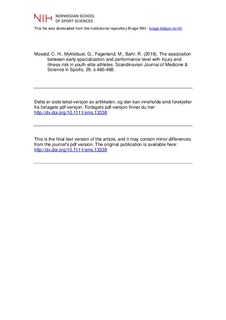| dc.contributor.author | Moseid, Christine Holm | |
| dc.contributor.author | Myklebust, Grethe | |
| dc.contributor.author | Fagerland, Morten | |
| dc.contributor.author | Bahr, Roald | |
| dc.date.accessioned | 2019-11-21T14:19:39Z | |
| dc.date.available | 2019-11-21T14:19:39Z | |
| dc.date.created | 2018-12-03T13:50:40Z | |
| dc.date.issued | 2018 | |
| dc.identifier.citation | Scandinavian Journal of Medicine & Science in Sports. 2019, 29, 460-468. | nb_NO |
| dc.identifier.issn | 0905-7188 | |
| dc.identifier.uri | http://hdl.handle.net/11250/2629883 | |
| dc.description | I Brage finner du siste tekst-versjon av artikkelen, og den kan inneholde ubetydelige forskjeller fra forlagets pdf-versjon. Forlagets pdf-versjon finner du på wiley.com / In Brage you'll find the final text version of the article, and it may contain insignificant differences from the journal's pdf version. The definitive version is available at wiley.com | nb_NO |
| dc.description.abstract | A trend is observed towards more specialized training and selection into talent programs at an early age for youth athletes. Little is known how this might influence the risk of illness and injury. The aim of the study was to assess whether, in a group of youth elite athletes, those specializing early or performing best were at increased risk of incurring injury or illness after entering a specialized Sport Academy High School program. We enrolled 259 16‐year old elite athletes. They completed a baseline web‐based questionnaire covering their age at specialization, single‐ versus multi‐sport involvement during the previous 2 years and current performance level (rated by themselves and their coach). Subsequently, the Oslo Sports Trauma Research Centre (OSTRC) questionnaire on health problems was used to self‐report injuries and illnesses weekly for 26 weeks from October to May. In this specialized Sport Academy High School program, 39% of the athletes reported early specialization (at 12 years or younger). However, early specialization did not increase the risk of injury or illness during the 26 weeks, nor did being a single‐sport athlete the previous two years increase this risk. The best performing athletes at the time of enrollment were not at greater risk of becoming injured or ill during the 26 weeks. In conclusion, in a group of youth elite athletes entering a specialized Sport Academy High School program neither early single‐sport specialization nor performance level appears to represent risk factors for injury or illness after enrollment. | nb_NO |
| dc.language.iso | eng | nb_NO |
| dc.subject | acute injury | nb_NO |
| dc.subject | adolescent | nb_NO |
| dc.subject | illness | nb_NO |
| dc.subject | overuse injury | nb_NO |
| dc.subject | performance level | nb_NO |
| dc.subject | single‐sport specialization | nb_NO |
| dc.subject | sport academy | nb_NO |
| dc.subject | talent | nb_NO |
| dc.title | The Association between Early Specialization and Performance Level with Injury and Illness Risk in Youth Elite Athletes | nb_NO |
| dc.type | Journal article | nb_NO |
| dc.type | Peer reviewed | nb_NO |
| dc.description.version | publishedVersion | nb_NO |
| dc.source.pagenumber | 460-468 | nb_NO |
| dc.source.volume | 29 | nb_NO |
| dc.source.journal | Scandinavian Journal of Medicine & Science in Sports | nb_NO |
| dc.identifier.doi | 10.1111/sms.13338 | |
| dc.identifier.cristin | 1638459 | |
| dc.description.localcode | Seksjon for idrettsmedisinske fag / Department of Sports Medicine | nb_NO |
| cristin.unitcode | 150,34,0,0 | |
| cristin.unitname | Seksjon for idrettsmedisinske fag | |
| cristin.ispublished | true | |
| cristin.fulltext | original | |
| cristin.qualitycode | 2 | |
